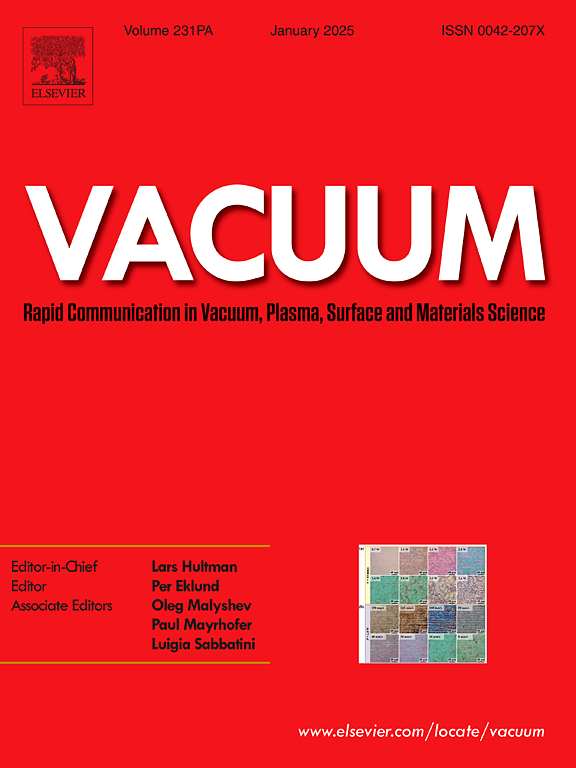Study on antibacterial efficiency of ZnO functionalized plasma-treated PMMA and PS polymer films for Bio-medical applications
IF 3.9
2区 材料科学
Q2 MATERIALS SCIENCE, MULTIDISCIPLINARY
引用次数: 0
Abstract
The utilization of polymer films in medical and food applications is often hindered by issues such as poor adhesion, inadequate antibacterial properties, and hydrophobic surfaces. Non-thermal plasma treatment has emerged as an effective technique to address these limitations and enhance film performance. This study investigates the effects of Zinc oxide(ZnO) functionalization on plasma-treated Polymethyl methacrylate(PMMA) and Polystyrene(PS) films. ZnO nanoparticles, synthesized through transferred arc plasma system, are characterized by UV–visible spectroscopy and X-ray diffraction analysis(XRD), revealing band gap energy of 3.29eV and crystalline size of 44.73 nm. Surface modifications of polymer films are achieved using Dielectric Barrier Discharge (DBD) plasma at 30 kV with argon gas for various exposure durations, followed by dip-coating in ZnO solution. Characterization results shows substantial improvements in hydrophilicity, chemical structure and surface roughness. Optical Emission Spectroscopy(OES) analysis reveals that argon plasma exhibits an electron temperature of 0.8 eV and electron density of 1.6 × 1016 cm−3. Antibacterial studies reveal that ZnO-functionalized plasma-treated PMMA films for 15 min exhibit superior antibacterial performance, showing a 12.5 ± 0.3 mm inhibition zone, while ZnO-functionalized plasma-treated PS films display a 9.3 ± 0.3 mm inhibition zone. This study highlights the potential of DBD plasma and ZnO coating to address existing challenges, enhancing polymer films for its use in bio-medical applications.

生物医学用ZnO功能化等离子体处理PMMA和PS聚合物薄膜的抗菌性能研究
聚合物薄膜在医疗和食品应用中的应用经常受到粘附性差、抗菌性能不足和疏水表面等问题的阻碍。非热等离子体处理已成为解决这些限制和提高薄膜性能的有效技术。研究了氧化锌(ZnO)功能化对等离子体处理的聚甲基丙烯酸甲酯(PMMA)和聚苯乙烯(PS)薄膜的影响。通过转移电弧等离子体体系合成的ZnO纳米粒子,通过紫外可见光谱和x射线衍射分析(XRD)对其进行了表征,发现能带能为3.29eV,晶粒尺寸为44.73 nm。采用介电阻挡放电(DBD)等离子体在30kv氩气条件下对聚合物薄膜进行不同时间的表面修饰,然后在ZnO溶液中浸涂。表征结果显示亲水性、化学结构和表面粗糙度都有很大改善。发射光谱(OES)分析表明,氩等离子体的电子温度为0.8 eV,电子密度为1.6 × 1016 cm−3。抑菌研究表明,zno功能化等离子体处理PMMA膜的抑菌面积为12.5±0.3 mm,而zno功能化等离子体处理PS膜的抑菌面积为9.3±0.3 mm。这项研究强调了DBD等离子体和ZnO涂层在解决现有挑战方面的潜力,增强了聚合物薄膜在生物医学领域的应用。
本文章由计算机程序翻译,如有差异,请以英文原文为准。
求助全文
约1分钟内获得全文
求助全文
来源期刊

Vacuum
工程技术-材料科学:综合
CiteScore
6.80
自引率
17.50%
发文量
0
审稿时长
34 days
期刊介绍:
Vacuum is an international rapid publications journal with a focus on short communication. All papers are peer-reviewed, with the review process for short communication geared towards very fast turnaround times. The journal also published full research papers, thematic issues and selected papers from leading conferences.
A report in Vacuum should represent a major advance in an area that involves a controlled environment at pressures of one atmosphere or below.
The scope of the journal includes:
1. Vacuum; original developments in vacuum pumping and instrumentation, vacuum measurement, vacuum gas dynamics, gas-surface interactions, surface treatment for UHV applications and low outgassing, vacuum melting, sintering, and vacuum metrology. Technology and solutions for large-scale facilities (e.g., particle accelerators and fusion devices). New instrumentation ( e.g., detectors and electron microscopes).
2. Plasma science; advances in PVD, CVD, plasma-assisted CVD, ion sources, deposition processes and analysis.
3. Surface science; surface engineering, surface chemistry, surface analysis, crystal growth, ion-surface interactions and etching, nanometer-scale processing, surface modification.
4. Materials science; novel functional or structural materials. Metals, ceramics, and polymers. Experiments, simulations, and modelling for understanding structure-property relationships. Thin films and coatings. Nanostructures and ion implantation.
 求助内容:
求助内容: 应助结果提醒方式:
应助结果提醒方式:


